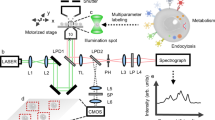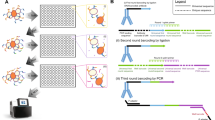Abstract
Mass cytometry facilitates high-dimensional, quantitative analysis of the effects of bioactive molecules on human samples at single-cell resolution, but instruments process only one sample at a time. Here we describe mass-tag cellular barcoding (MCB), which increases mass cytometry throughput by using n metal ion tags to multiplex up to 2n samples. We used seven tags to multiplex an entire 96-well plate, and applied MCB to characterize human peripheral blood mononuclear cell (PBMC) signaling dynamics and cell-to-cell communication, signaling variability between PBMCs from eight human donors, and the effects of 27 inhibitors on this system. For each inhibitor, we measured 14 phosphorylation sites in 14 PBMC types at 96 conditions, resulting in 18,816 quantified phosphorylation levels from each multiplexed sample. This high-dimensional, systems-level inquiry allowed analysis across cell-type and signaling space, reclassified inhibitors and revealed off-target effects. High-content, high-throughput screening with MCB should be useful for drug discovery, preclinical testing and mechanistic investigation of human disease.
This is a preview of subscription content, access via your institution
Access options
Subscribe to this journal
Receive 12 print issues and online access
$209.00 per year
only $17.42 per issue
Buy this article
- Purchase on Springer Link
- Instant access to full article PDF
Prices may be subject to local taxes which are calculated during checkout






Similar content being viewed by others
Change history
23 August 2012
In the version of this article initially published online, in the legend for Figure 2e, LPS stimulation was said to be by “NFκB, STAT3 and STAT1,” instead of by “NFκB, STAT3 and BTK/ITK.” The error has been corrected for the print, PDF and HTML versions of this article.
References
Paul, S.M. et al. How to improve R&D productivity: the pharmaceutical industry's grand challenge. Nat. Rev. Drug Discov. 9, 203–214 (2010).
Nolan, G.P. What's wrong with drug screening today. Nat. Chem. Biol. 3, 187–191 (2007).
Kola, I. & Landis, J. Can the pharmaceutical industry reduce attrition rates? Nat. Rev. Drug Discov. 3, 711–715 (2004).
Kramer, J.A., Sagartz, J.E. & Morris, D.L. The application of discovery toxicology and pathology towards the design of safer pharmaceutical lead candidates. Nat. Rev. Drug Discov. 6, 636–649 (2007).
Kolch, W. & Pitt, A. Functional proteomics to dissect tyrosine kinase signalling pathways in cancer. Nat. Rev. Cancer 10, 618–629 (2010).
Bodenmiller, B. et al. Phosphoproteomic analysis reveals interconnected system-wide responses to perturbations of kinases and phosphatases in yeast. Sci. Signal. 3, rs4 (2010).
Zhang, J., Yang, P.L. & Gray, N.S. Targeting cancer with small molecule kinase inhibitors. Nat. Rev. Cancer 9, 28–39 (2009).
Hynes, N.E. & Lane, H.A. ERBB receptors and cancer: the complexity of targeted inhibitors. Nat. Rev. Cancer 5, 341–354 (2005).
Irish, J.M., Kotecha, N. & Nolan, G.P. Mapping normal and cancer cell signalling networks: towards single-cell proteomics. Nat. Rev. Cancer 6, 146–155 (2006).
Knight, Z.A., Lin, H. & Shokat, K.M. Targeting the cancer kinome through polypharmacology. Nat. Rev. Cancer 10, 130–137 (2010).
Arrell, D.K. & Terzic, A. Network systems biology for drug discovery. Clin. Pharmacol. Ther. 88, 120–125 (2010).
Irish, J.M. et al. Single cell profiling of potentiated phospho-protein networks in cancer cells. Cell 118, 217–228 (2004).
Fabian, M.A. et al. A small molecule-kinase interaction map for clinical kinase inhibitors. Nat. Biotechnol. 23, 329–336 (2005).
Karaman, M.W. et al. A quantitative analysis of kinase inhibitor selectivity. Nat. Biotechnol. 26, 127–132 (2008).
Bamborough, P., Drewry, D., Harper, G., Smith, G.K. & Schneider, K. Assessment of chemical coverage of kinome space and its implications for kinase drug discovery. J. Med. Chem. 51, 7898–7914 (2008).
Anastassiadis, T., Deacon, S.W., Devarajan, K., Ma, H. & Peterson, J.R. Comprehensive assay of kinase catalytic activity reveals features of kinase inhibitor selectivity. Nat. Biotechnol. 29, 1039–1045 (2011).
Davis, M.I. et al. Comprehensive analysis of kinase inhibitor selectivity. Nat. Biotechnol. 29, 1046–1051 (2011).
Melnick, J.S. et al. An efficient rapid system for profiling the cellular activities of molecular libraries. Proc. Natl. Acad. Sci. USA 103, 3153–3158 (2006).
Evans, W.E. & Relling, M.V. Pharmacogenomics: translating functional genomics into rational therapeutics. Science 286, 487–491 (1999).
Kramer, R. & Cohen, D. Functional genomics to new drug targets. Nat. Rev. Drug Discov. 3, 965–972 (2004).
Bantscheff, M. et al. Quantitative chemical proteomics reveals mechanisms of action of clinical ABL kinase inhibitors. Nat. Biotechnol. 25, 1035–1044 (2007).
Bantscheff, M., Scholten, A. & Heck, A.J. Revealing promiscuous drug-target interactions by chemical proteomics. Drug Discov. Today 14, 1021–1029 (2009).
Perlman, Z.E. et al. Multidimensional drug profiling by automated microscopy. Science 306, 1194–1198 (2004).
Singh, D.K. et al. Patterns of basal signaling heterogeneity can distinguish cellular populations with different drug sensitivities. Mol. Syst. Biol. 6, 369 (2010).
Geva-Zatorsky, N. et al. Protein dynamics in drug combinations: a linear superposition of individual-drug responses. Cell 140, 643–651 (2010).
Hulett, H.R., Bonner, W.A., Barrett, J. & Herzenberg, L.A. Cell sorting: automated separation of mammalian cells as a function of intracellular fluorescence. Science 166, 747–749 (1969).
Perfetto, S.P., Chattopadhyay, P.K. & Roederer, M. Seventeen-colour flow cytometry: unravelling the immune system. Nat. Rev. Immunol. 4, 648–655 (2004).
Chattopadhyay, P.K. et al. Quantum dot semiconductor nanocrystals for immunophenotyping by polychromatic flow cytometry. Nat. Med. 12, 972–977 (2006).
Perez, O.D. & Nolan, G.P. Simultaneous measurement of multiple active kinase states using polychromatic flow cytometry. Nat. Biotechnol. 20, 155–162 (2002).
Young, S.M. et al. High-throughput screening with HyperCyt flow cytometry to detect small molecule formylpeptide receptor ligands. J. Biomol. Screen. 10, 374–382 (2005).
Bartsch, J.W. et al. An investigation of liquid carryover and sample residual for a high-throughput flow cytometer sample delivery system. Anal. Chem. 76, 3810–3817 (2004).
Krutzik, P.O., Crane, J.M., Clutter, M.R. & Nolan, G.P. High-content single-cell drug screening with phosphospecific flow cytometry. Nat. Chem. Biol. 4, 132–142 (2008).
Krutzik, P.O. & Nolan, G.P. Fluorescent cell barcoding in flow cytometry allows high-throughput drug screening and signaling profiling. Nat. Methods 3, 361–368 (2006).
Bandura, D.R. et al. Mass cytometry: technique for real time single cell multitarget immunoassay based on inductively coupled plasma time-of-flight mass spectrometry. Anal. Chem. 81, 6813–6822 (2009).
Bendall, S.C. et al. Single-cell mass cytometry of differential immune and drug responses across a human hematopoietic continuum. Science 332, 687–696 (2011).
Lou, X. et al. Polymer-based elemental tags for sensitive bioassays. Angew. Chem. Int. Edn. Engl. 46, 6111–6114 (2007).
Qiu, P. et al. Extracting a cellular hierarchy from high-dimensional cytometry data with SPADE. Nat. Biotechnol. 29, 886–891 (2011).
Shuai, K. & Liu, B. Regulation of JAK-STAT signalling in the immune system. Nat. Rev. Immunol. 3, 900–911 (2003).
Rawlings, J.S., Rosler, K.M. & Harrison, D.A. The JAK/STAT signaling pathway. J. Cell Sci. 117, 1281–1283 (2004).
Platanias, L.C. Mechanisms of type-I- and type-II-interferon-mediated signalling. Nat. Rev. Immunol. 5, 375–386 (2005).
Novershtern, N. et al. Densely interconnected transcriptional circuits control cell states in human hematopoiesis. Cell 144, 296–309 (2011).
Akira, S. & Takeda, K. Toll-like receptor signalling. Nat. Rev. Immunol. 4, 499–511 (2004).
Andersson, U. & Matsuda, T. Human interleukin 6 and tumor necrosis factor alpha production studied at a single-cell level. Eur. J. Immunol. 19, 1157–1160 (1989).
Perez-Oliva, A.B. et al. Epitope mapping, expression and post-translational modifications of two isoforms of CD33 (CD33M and CD33m) on lymphoid and myeloid human cells. Glycobiology 21, 757–770 (2011).
Deisseroth, A. et al. U.s. Food and drug administration approval: ruxolitinib for the treatment of patients with intermediate and high-risk myelofibrosis. Clin. Cancer Res. 18, 3212–3217 (2012).
Knight, Z.A. & Shokat, K.M. Features of selective kinase inhibitors. Chem. Biol. 12, 621–637 (2005).
Lown, J.W. The mechanism of action of quinone antibiotics. Mol. Cell. Biochem. 55, 17–40 (1983).
Pardanani, A. JAK2 inhibitor therapy in myeloproliferative disorders: rationale, preclinical studies and ongoing clinical trials. Leukemia 22, 23–30 (2008).
Brandman, O., Ferrell, J.E. Jr, Li, R. & Meyer, T. Interlinked fast and slow positive feedback loops drive reliable cell decisions. Science 310, 496–498 (2005).
Jorgensen, C. et al. Cell-specific information processing in segregating populations of Eph receptor ephrin-expressing cells. Science 326, 1502–1509 (2009).
Acknowledgements
We would like to thank A. Trejo, M. Clutter, K. Gibbs and G. Behbahani for their experimental support and discussions, and D. Pe'er and El-ad D. Amir for their feedback on data analysis. B.B. was supported by fellowships of the Swiss National Science Foundation (SNF), the European Molecular Biology Organization (EMBO), and the Marie Curie IOF. E.R.Z. is supported by a fellowship from National Institute of General Medical Sciences (F32GM093508). T.J.C. is supported by the Department of Defense (DoD) through the National Defense Science & Engineering Graduate Fellowship (NDSEG) Program, and the Stanford Graduate Fellowship in Science and Engineering. S.C.B. is supported by the Damon Runyon Cancer Research Foundation Fellowship (DRG-2017-09). G.P.N. is supported by the Rachford and Carlota A. Harris Endowed Professorship and grants from U19 AI057229, P01 CA034233, HHSN272200700038C, 1R01CA130826, CIRM DR1-01477 and RB2-01592, NCI RFA CA 09-011, NHLBI-HV-10-05(2), European Commission HEALTH.2010.1.2-1, and the Bill and Melinda Gates Foundation (GF12141-137101).
Author information
Authors and Affiliations
Contributions
B.B. conceived and designed the experiments, performed all PBMC experiments, MCB multiplexing and mass cytometry analysis, analyzed the data and wrote the manuscript. E.R.Z. conceived and designed the experiments, developed the mDOTA reagents, performed all PBMC experiments, MCB multiplexing and mass cytometry analysis, analyzed the data and wrote the manuscript. R.F. designed and implemented algorithms and software tools for barcode deconvolution, semi-automatic cell-type gating and dose-response analysis. T.J.C. performed PCA and assisted with data analysis. E.S.S. designed and implemented high-density data visualization. R.V.B. designed and implemented scripts for FCS file processing and assisted with SPADE analysis. E.F.S. assisted with SPADE analysis, designed the 96-well barcoding scheme. S.C.B. assisted with antibody labeling and running the mass cytometer, and high-dimensional analysis of human immune cell populations. K.S. helped with bioinformatic data analysis. P.O.K. conceived cell barcoding for mass cytometry. G.P.N. conceived and designed the experiments, wrote the manuscript. All authors read and approved the final manuscript.
Corresponding author
Ethics declarations
Competing interests
G.P.N. has personal financial interest in the companies Nodality, DVS Sciences and Becton Dickinson, the manufacturers that produce the reagents or instrumentation used in this manuscript.
Supplementary information
Supplementary Text and Figures
Supplementary Notes 1–8, Supplementary Tables 1–3, Supplementary Methods Tables 1–3, Supplementary Methods Figure 1 and Supplementary Figures 1–29 (PDF 7755 kb)
Rights and permissions
About this article
Cite this article
Bodenmiller, B., Zunder, E., Finck, R. et al. Multiplexed mass cytometry profiling of cellular states perturbed by small-molecule regulators. Nat Biotechnol 30, 858–867 (2012). https://doi.org/10.1038/nbt.2317
Received:
Accepted:
Published:
Issue Date:
DOI: https://doi.org/10.1038/nbt.2317
This article is cited by
-
Benchmarking differential abundance methods for finding condition-specific prototypical cells in multi-sample single-cell datasets
Genome Biology (2024)
-
SuperCellCyto: enabling efficient analysis of large scale cytometry datasets
Genome Biology (2024)
-
High-dimensional multi-pass flow cytometry via spectrally encoded cellular barcoding
Nature Biomedical Engineering (2023)
-
Detecting radio- and chemoresistant cells in 3D cancer co-cultures using chromatin biomarkers
Scientific Reports (2023)
-
Machine learning phenomics (MLP) combining deep learning with time-lapse-microscopy for monitoring colorectal adenocarcinoma cells gene expression and drug-response
Scientific Reports (2022)



